A Comprehensive Analysis of Leadership and Management at Tesco
VerifiedAdded on 2021/02/20
|12
|3277
|30
Report
AI Summary
This report provides a comprehensive analysis of leadership and management practices within Tesco, a British multinational retail company. It begins by defining and comparing the roles and characteristics of leaders and managers, highlighting their distinct responsibilities and attributes. The report then examines how these roles apply in different situational contexts, such as raising brand image and decreasing employee turnover, illustrating the importance of both leadership and management in achieving business objectives. Various leadership theories and models, including situational leadership, systems leadership, and contingency leadership, are explored to understand their application within Tesco. Furthermore, the report delves into the key approaches to operations management, such as just-in-time inventory, total quality management, and the Six-Sigma approach, and analyzes the roles that leaders and managers play in implementing these strategies. The importance and value of operations management in achieving business objectives, particularly in terms of waste reduction, are also discussed. Overall, the report offers valuable insights into the leadership and management dynamics that drive operational success within a large retail organization like Tesco.
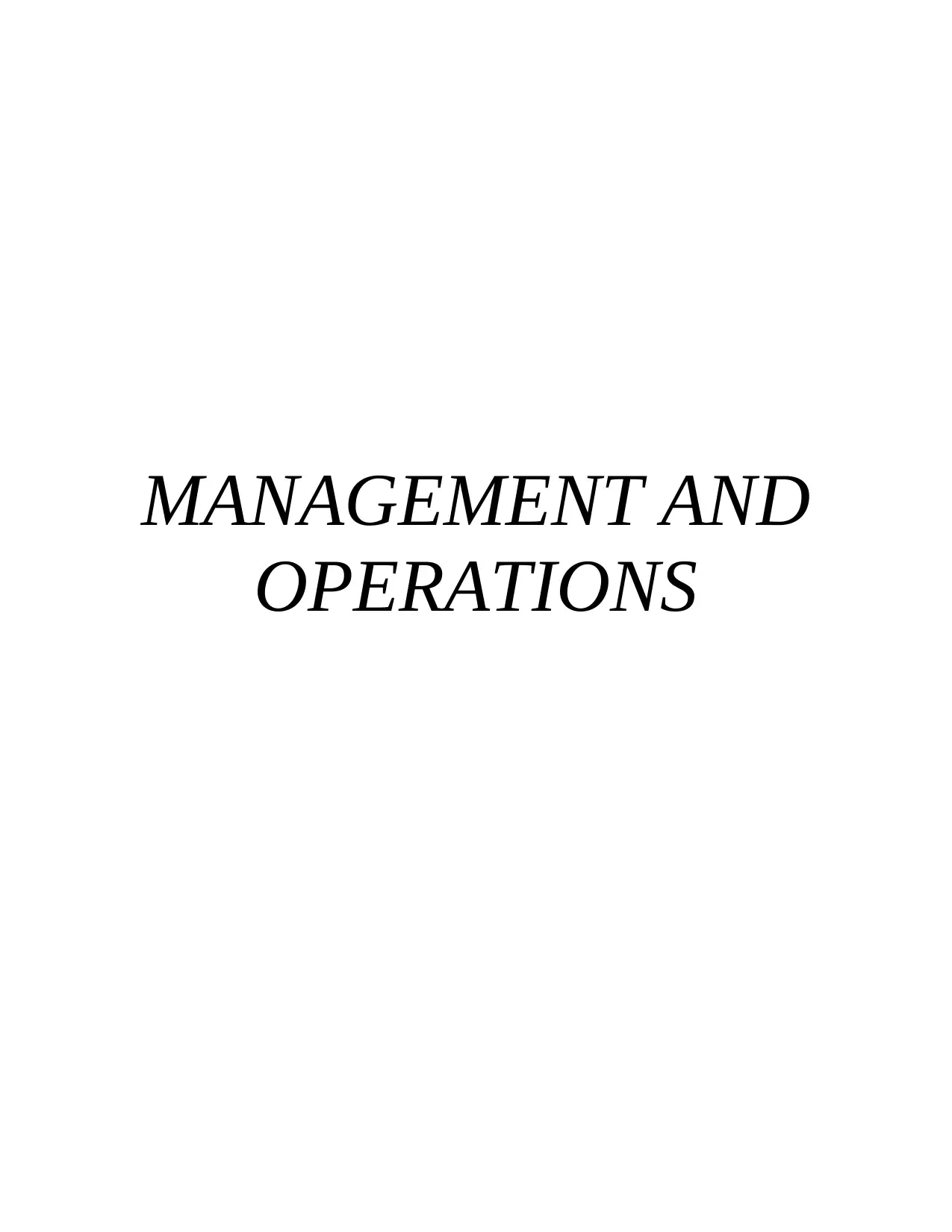
MANAGEMENT AND
OPERATIONS
OPERATIONS
Paraphrase This Document
Need a fresh take? Get an instant paraphrase of this document with our AI Paraphraser
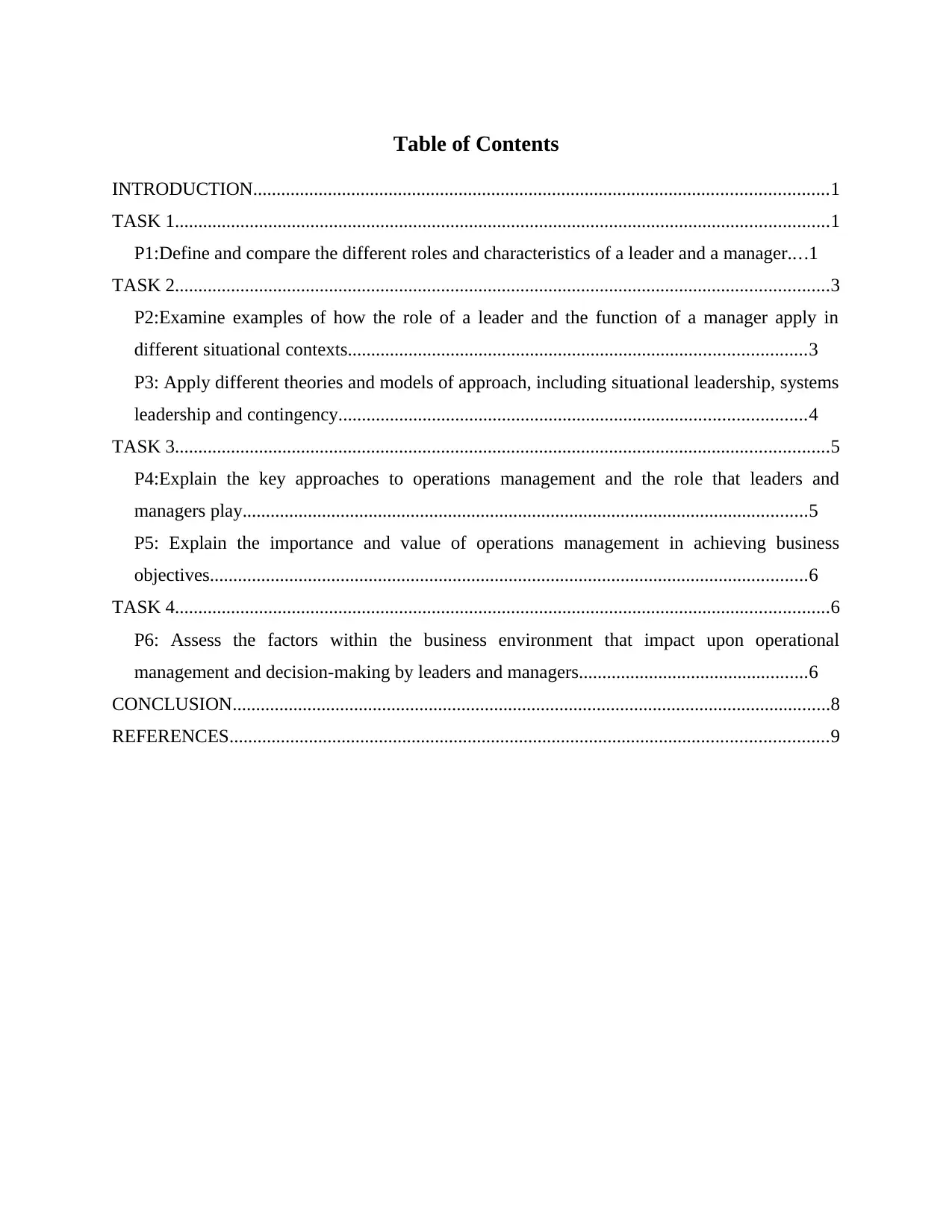
Table of Contents
INTRODUCTION...........................................................................................................................1
TASK 1............................................................................................................................................1
P1:Define and compare the different roles and characteristics of a leader and a manager....1
TASK 2............................................................................................................................................3
P2:Examine examples of how the role of a leader and the function of a manager apply in
different situational contexts..................................................................................................3
P3: Apply different theories and models of approach, including situational leadership, systems
leadership and contingency....................................................................................................4
TASK 3............................................................................................................................................5
P4:Explain the key approaches to operations management and the role that leaders and
managers play.........................................................................................................................5
P5: Explain the importance and value of operations management in achieving business
objectives................................................................................................................................6
TASK 4............................................................................................................................................6
P6: Assess the factors within the business environment that impact upon operational
management and decision-making by leaders and managers.................................................6
CONCLUSION................................................................................................................................8
REFERENCES................................................................................................................................9
INTRODUCTION...........................................................................................................................1
TASK 1............................................................................................................................................1
P1:Define and compare the different roles and characteristics of a leader and a manager....1
TASK 2............................................................................................................................................3
P2:Examine examples of how the role of a leader and the function of a manager apply in
different situational contexts..................................................................................................3
P3: Apply different theories and models of approach, including situational leadership, systems
leadership and contingency....................................................................................................4
TASK 3............................................................................................................................................5
P4:Explain the key approaches to operations management and the role that leaders and
managers play.........................................................................................................................5
P5: Explain the importance and value of operations management in achieving business
objectives................................................................................................................................6
TASK 4............................................................................................................................................6
P6: Assess the factors within the business environment that impact upon operational
management and decision-making by leaders and managers.................................................6
CONCLUSION................................................................................................................................8
REFERENCES................................................................................................................................9

⊘ This is a preview!⊘
Do you want full access?
Subscribe today to unlock all pages.

Trusted by 1+ million students worldwide
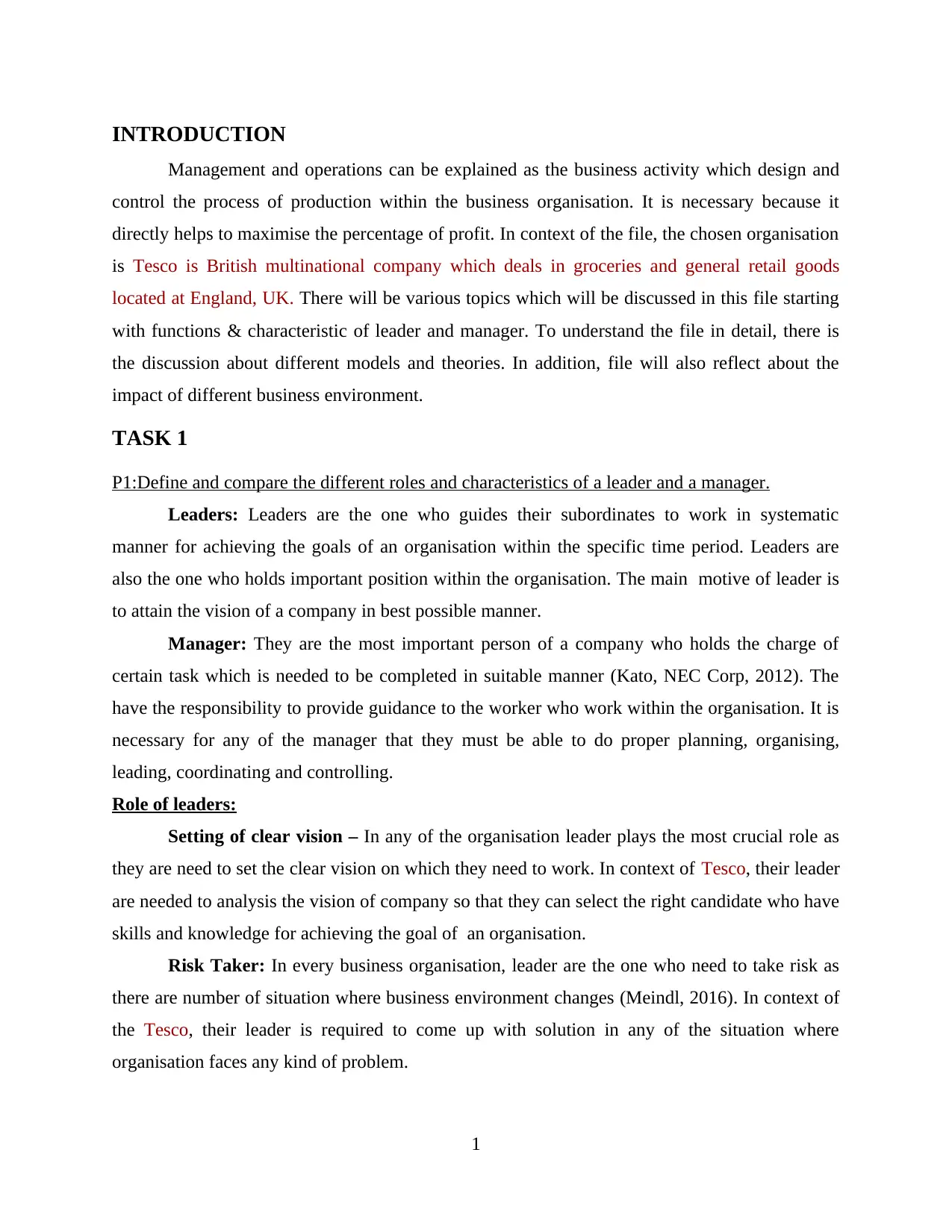
INTRODUCTION
Management and operations can be explained as the business activity which design and
control the process of production within the business organisation. It is necessary because it
directly helps to maximise the percentage of profit. In context of the file, the chosen organisation
is Tesco is British multinational company which deals in groceries and general retail goods
located at England, UK. There will be various topics which will be discussed in this file starting
with functions & characteristic of leader and manager. To understand the file in detail, there is
the discussion about different models and theories. In addition, file will also reflect about the
impact of different business environment.
TASK 1
P1:Define and compare the different roles and characteristics of a leader and a manager.
Leaders: Leaders are the one who guides their subordinates to work in systematic
manner for achieving the goals of an organisation within the specific time period. Leaders are
also the one who holds important position within the organisation. The main motive of leader is
to attain the vision of a company in best possible manner.
Manager: They are the most important person of a company who holds the charge of
certain task which is needed to be completed in suitable manner (Kato, NEC Corp, 2012). The
have the responsibility to provide guidance to the worker who work within the organisation. It is
necessary for any of the manager that they must be able to do proper planning, organising,
leading, coordinating and controlling.
Role of leaders:
Setting of clear vision – In any of the organisation leader plays the most crucial role as
they are need to set the clear vision on which they need to work. In context of Tesco, their leader
are needed to analysis the vision of company so that they can select the right candidate who have
skills and knowledge for achieving the goal of an organisation.
Risk Taker: In every business organisation, leader are the one who need to take risk as
there are number of situation where business environment changes (Meindl, 2016). In context of
the Tesco, their leader is required to come up with solution in any of the situation where
organisation faces any kind of problem.
1
Management and operations can be explained as the business activity which design and
control the process of production within the business organisation. It is necessary because it
directly helps to maximise the percentage of profit. In context of the file, the chosen organisation
is Tesco is British multinational company which deals in groceries and general retail goods
located at England, UK. There will be various topics which will be discussed in this file starting
with functions & characteristic of leader and manager. To understand the file in detail, there is
the discussion about different models and theories. In addition, file will also reflect about the
impact of different business environment.
TASK 1
P1:Define and compare the different roles and characteristics of a leader and a manager.
Leaders: Leaders are the one who guides their subordinates to work in systematic
manner for achieving the goals of an organisation within the specific time period. Leaders are
also the one who holds important position within the organisation. The main motive of leader is
to attain the vision of a company in best possible manner.
Manager: They are the most important person of a company who holds the charge of
certain task which is needed to be completed in suitable manner (Kato, NEC Corp, 2012). The
have the responsibility to provide guidance to the worker who work within the organisation. It is
necessary for any of the manager that they must be able to do proper planning, organising,
leading, coordinating and controlling.
Role of leaders:
Setting of clear vision – In any of the organisation leader plays the most crucial role as
they are need to set the clear vision on which they need to work. In context of Tesco, their leader
are needed to analysis the vision of company so that they can select the right candidate who have
skills and knowledge for achieving the goal of an organisation.
Risk Taker: In every business organisation, leader are the one who need to take risk as
there are number of situation where business environment changes (Meindl, 2016). In context of
the Tesco, their leader is required to come up with solution in any of the situation where
organisation faces any kind of problem.
1
Paraphrase This Document
Need a fresh take? Get an instant paraphrase of this document with our AI Paraphraser
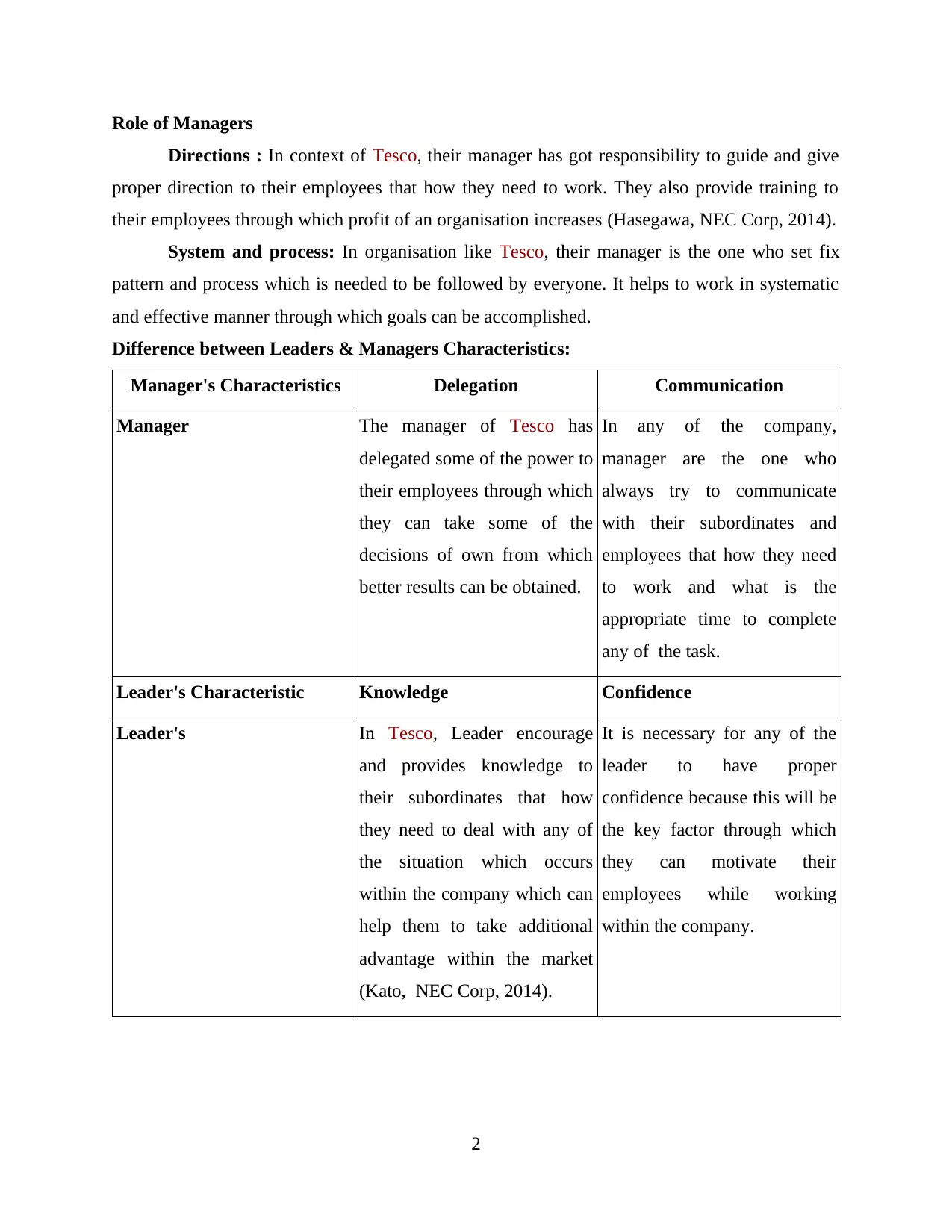
Role of Managers
Directions : In context of Tesco, their manager has got responsibility to guide and give
proper direction to their employees that how they need to work. They also provide training to
their employees through which profit of an organisation increases (Hasegawa, NEC Corp, 2014).
System and process: In organisation like Tesco, their manager is the one who set fix
pattern and process which is needed to be followed by everyone. It helps to work in systematic
and effective manner through which goals can be accomplished.
Difference between Leaders & Managers Characteristics:
Manager's Characteristics Delegation Communication
Manager The manager of Tesco has
delegated some of the power to
their employees through which
they can take some of the
decisions of own from which
better results can be obtained.
In any of the company,
manager are the one who
always try to communicate
with their subordinates and
employees that how they need
to work and what is the
appropriate time to complete
any of the task.
Leader's Characteristic Knowledge Confidence
Leader's In Tesco, Leader encourage
and provides knowledge to
their subordinates that how
they need to deal with any of
the situation which occurs
within the company which can
help them to take additional
advantage within the market
(Kato, NEC Corp, 2014).
It is necessary for any of the
leader to have proper
confidence because this will be
the key factor through which
they can motivate their
employees while working
within the company.
2
Directions : In context of Tesco, their manager has got responsibility to guide and give
proper direction to their employees that how they need to work. They also provide training to
their employees through which profit of an organisation increases (Hasegawa, NEC Corp, 2014).
System and process: In organisation like Tesco, their manager is the one who set fix
pattern and process which is needed to be followed by everyone. It helps to work in systematic
and effective manner through which goals can be accomplished.
Difference between Leaders & Managers Characteristics:
Manager's Characteristics Delegation Communication
Manager The manager of Tesco has
delegated some of the power to
their employees through which
they can take some of the
decisions of own from which
better results can be obtained.
In any of the company,
manager are the one who
always try to communicate
with their subordinates and
employees that how they need
to work and what is the
appropriate time to complete
any of the task.
Leader's Characteristic Knowledge Confidence
Leader's In Tesco, Leader encourage
and provides knowledge to
their subordinates that how
they need to deal with any of
the situation which occurs
within the company which can
help them to take additional
advantage within the market
(Kato, NEC Corp, 2014).
It is necessary for any of the
leader to have proper
confidence because this will be
the key factor through which
they can motivate their
employees while working
within the company.
2
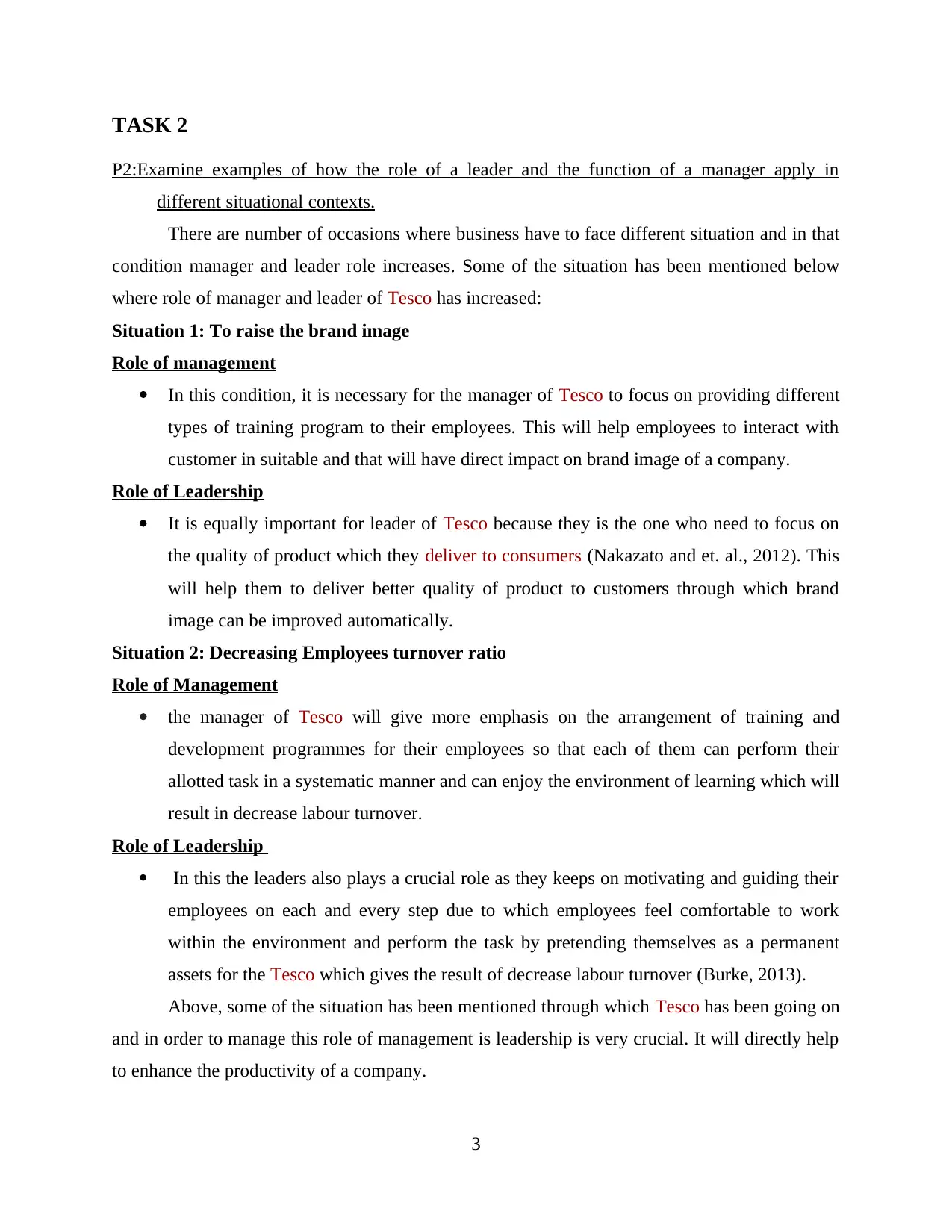
TASK 2
P2:Examine examples of how the role of a leader and the function of a manager apply in
different situational contexts.
There are number of occasions where business have to face different situation and in that
condition manager and leader role increases. Some of the situation has been mentioned below
where role of manager and leader of Tesco has increased:
Situation 1: To raise the brand image
Role of management
In this condition, it is necessary for the manager of Tesco to focus on providing different
types of training program to their employees. This will help employees to interact with
customer in suitable and that will have direct impact on brand image of a company.
Role of Leadership
It is equally important for leader of Tesco because they is the one who need to focus on
the quality of product which they deliver to consumers (Nakazato and et. al., 2012). This
will help them to deliver better quality of product to customers through which brand
image can be improved automatically.
Situation 2: Decreasing Employees turnover ratio
Role of Management
the manager of Tesco will give more emphasis on the arrangement of training and
development programmes for their employees so that each of them can perform their
allotted task in a systematic manner and can enjoy the environment of learning which will
result in decrease labour turnover.
Role of Leadership
In this the leaders also plays a crucial role as they keeps on motivating and guiding their
employees on each and every step due to which employees feel comfortable to work
within the environment and perform the task by pretending themselves as a permanent
assets for the Tesco which gives the result of decrease labour turnover (Burke, 2013).
Above, some of the situation has been mentioned through which Tesco has been going on
and in order to manage this role of management is leadership is very crucial. It will directly help
to enhance the productivity of a company.
3
P2:Examine examples of how the role of a leader and the function of a manager apply in
different situational contexts.
There are number of occasions where business have to face different situation and in that
condition manager and leader role increases. Some of the situation has been mentioned below
where role of manager and leader of Tesco has increased:
Situation 1: To raise the brand image
Role of management
In this condition, it is necessary for the manager of Tesco to focus on providing different
types of training program to their employees. This will help employees to interact with
customer in suitable and that will have direct impact on brand image of a company.
Role of Leadership
It is equally important for leader of Tesco because they is the one who need to focus on
the quality of product which they deliver to consumers (Nakazato and et. al., 2012). This
will help them to deliver better quality of product to customers through which brand
image can be improved automatically.
Situation 2: Decreasing Employees turnover ratio
Role of Management
the manager of Tesco will give more emphasis on the arrangement of training and
development programmes for their employees so that each of them can perform their
allotted task in a systematic manner and can enjoy the environment of learning which will
result in decrease labour turnover.
Role of Leadership
In this the leaders also plays a crucial role as they keeps on motivating and guiding their
employees on each and every step due to which employees feel comfortable to work
within the environment and perform the task by pretending themselves as a permanent
assets for the Tesco which gives the result of decrease labour turnover (Burke, 2013).
Above, some of the situation has been mentioned through which Tesco has been going on
and in order to manage this role of management is leadership is very crucial. It will directly help
to enhance the productivity of a company.
3
⊘ This is a preview!⊘
Do you want full access?
Subscribe today to unlock all pages.

Trusted by 1+ million students worldwide
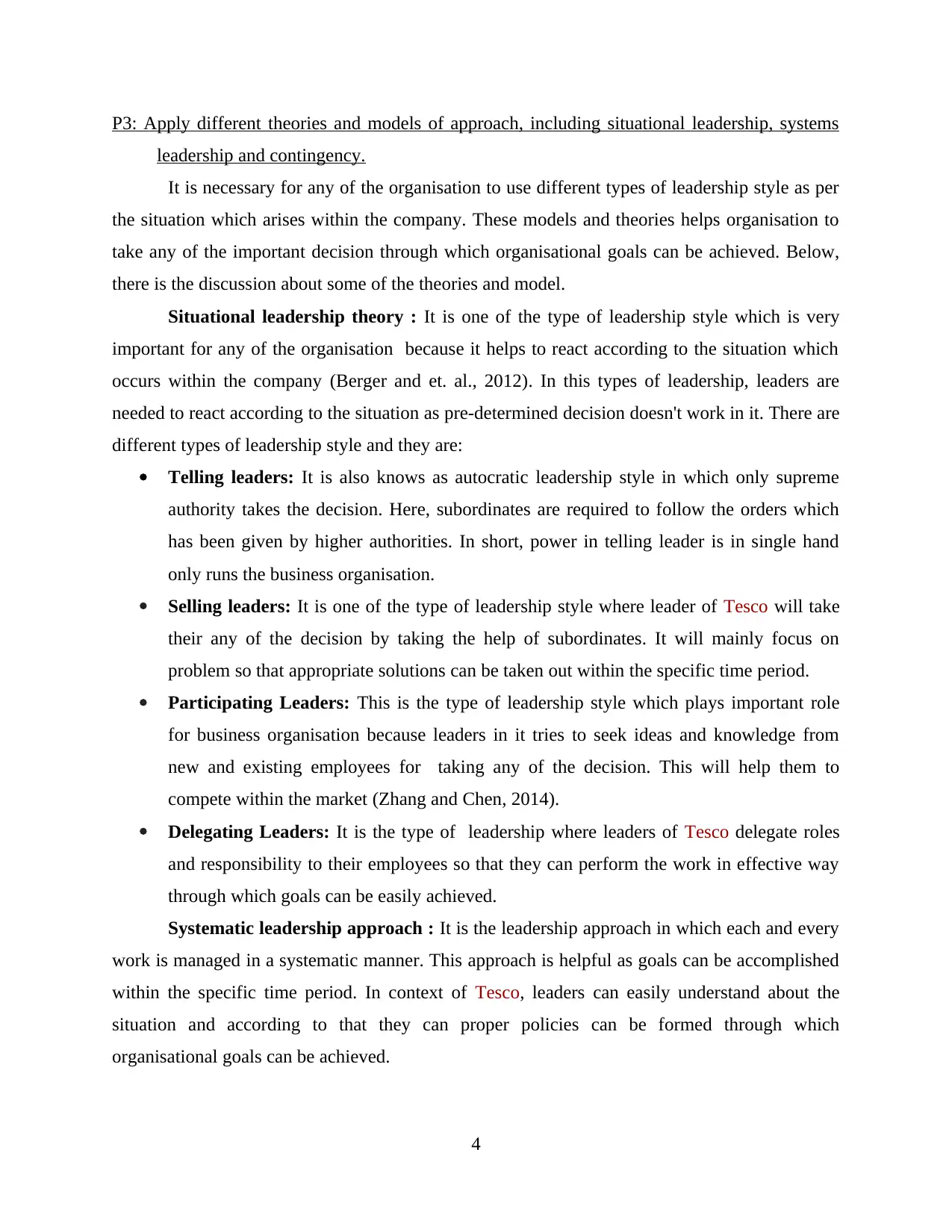
P3: Apply different theories and models of approach, including situational leadership, systems
leadership and contingency.
It is necessary for any of the organisation to use different types of leadership style as per
the situation which arises within the company. These models and theories helps organisation to
take any of the important decision through which organisational goals can be achieved. Below,
there is the discussion about some of the theories and model.
Situational leadership theory : It is one of the type of leadership style which is very
important for any of the organisation because it helps to react according to the situation which
occurs within the company (Berger and et. al., 2012). In this types of leadership, leaders are
needed to react according to the situation as pre-determined decision doesn't work in it. There are
different types of leadership style and they are:
Telling leaders: It is also knows as autocratic leadership style in which only supreme
authority takes the decision. Here, subordinates are required to follow the orders which
has been given by higher authorities. In short, power in telling leader is in single hand
only runs the business organisation.
Selling leaders: It is one of the type of leadership style where leader of Tesco will take
their any of the decision by taking the help of subordinates. It will mainly focus on
problem so that appropriate solutions can be taken out within the specific time period.
Participating Leaders: This is the type of leadership style which plays important role
for business organisation because leaders in it tries to seek ideas and knowledge from
new and existing employees for taking any of the decision. This will help them to
compete within the market (Zhang and Chen, 2014).
Delegating Leaders: It is the type of leadership where leaders of Tesco delegate roles
and responsibility to their employees so that they can perform the work in effective way
through which goals can be easily achieved.
Systematic leadership approach : It is the leadership approach in which each and every
work is managed in a systematic manner. This approach is helpful as goals can be accomplished
within the specific time period. In context of Tesco, leaders can easily understand about the
situation and according to that they can proper policies can be formed through which
organisational goals can be achieved.
4
leadership and contingency.
It is necessary for any of the organisation to use different types of leadership style as per
the situation which arises within the company. These models and theories helps organisation to
take any of the important decision through which organisational goals can be achieved. Below,
there is the discussion about some of the theories and model.
Situational leadership theory : It is one of the type of leadership style which is very
important for any of the organisation because it helps to react according to the situation which
occurs within the company (Berger and et. al., 2012). In this types of leadership, leaders are
needed to react according to the situation as pre-determined decision doesn't work in it. There are
different types of leadership style and they are:
Telling leaders: It is also knows as autocratic leadership style in which only supreme
authority takes the decision. Here, subordinates are required to follow the orders which
has been given by higher authorities. In short, power in telling leader is in single hand
only runs the business organisation.
Selling leaders: It is one of the type of leadership style where leader of Tesco will take
their any of the decision by taking the help of subordinates. It will mainly focus on
problem so that appropriate solutions can be taken out within the specific time period.
Participating Leaders: This is the type of leadership style which plays important role
for business organisation because leaders in it tries to seek ideas and knowledge from
new and existing employees for taking any of the decision. This will help them to
compete within the market (Zhang and Chen, 2014).
Delegating Leaders: It is the type of leadership where leaders of Tesco delegate roles
and responsibility to their employees so that they can perform the work in effective way
through which goals can be easily achieved.
Systematic leadership approach : It is the leadership approach in which each and every
work is managed in a systematic manner. This approach is helpful as goals can be accomplished
within the specific time period. In context of Tesco, leaders can easily understand about the
situation and according to that they can proper policies can be formed through which
organisational goals can be achieved.
4
Paraphrase This Document
Need a fresh take? Get an instant paraphrase of this document with our AI Paraphraser
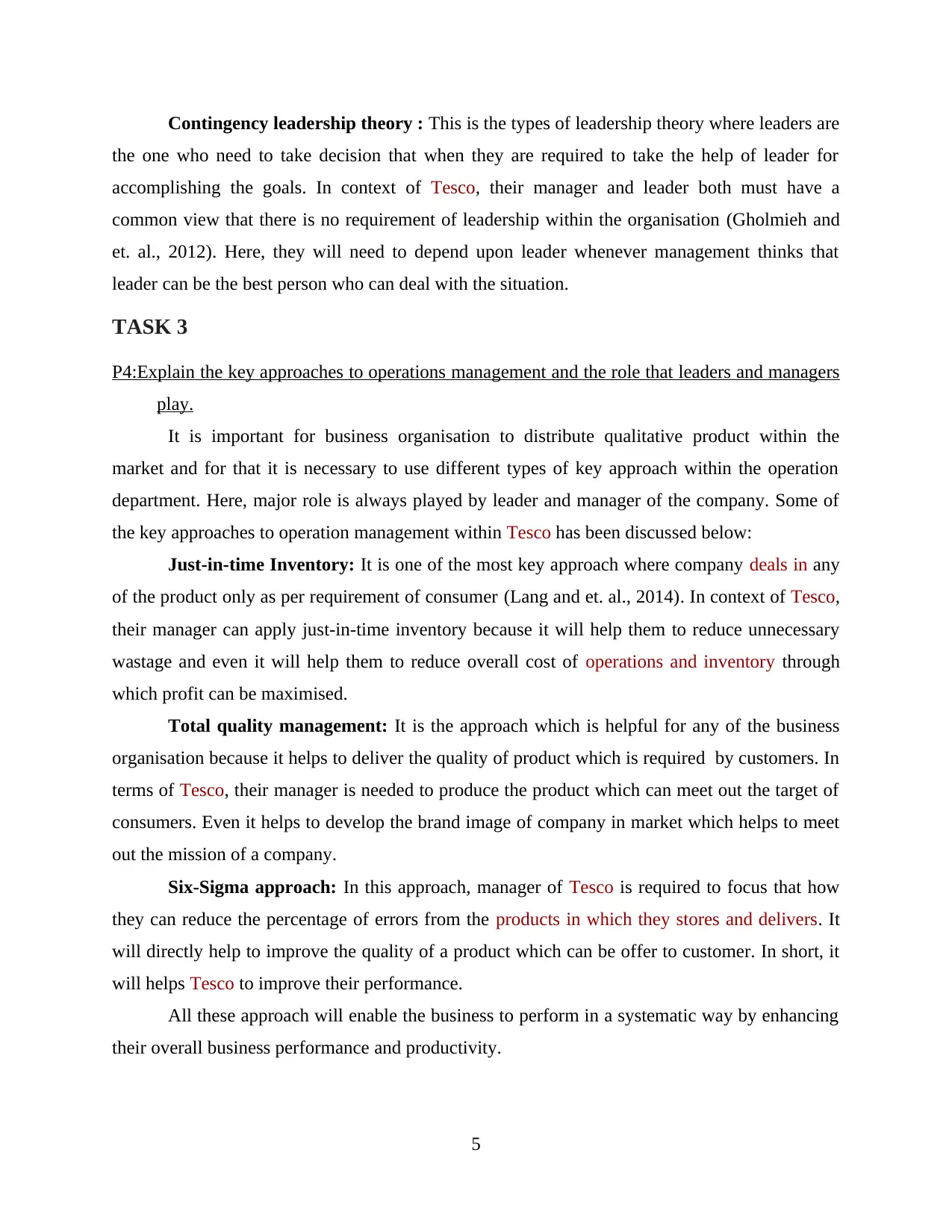
Contingency leadership theory : This is the types of leadership theory where leaders are
the one who need to take decision that when they are required to take the help of leader for
accomplishing the goals. In context of Tesco, their manager and leader both must have a
common view that there is no requirement of leadership within the organisation (Gholmieh and
et. al., 2012). Here, they will need to depend upon leader whenever management thinks that
leader can be the best person who can deal with the situation.
TASK 3
P4:Explain the key approaches to operations management and the role that leaders and managers
play.
It is important for business organisation to distribute qualitative product within the
market and for that it is necessary to use different types of key approach within the operation
department. Here, major role is always played by leader and manager of the company. Some of
the key approaches to operation management within Tesco has been discussed below:
Just-in-time Inventory: It is one of the most key approach where company deals in any
of the product only as per requirement of consumer (Lang and et. al., 2014). In context of Tesco,
their manager can apply just-in-time inventory because it will help them to reduce unnecessary
wastage and even it will help them to reduce overall cost of operations and inventory through
which profit can be maximised.
Total quality management: It is the approach which is helpful for any of the business
organisation because it helps to deliver the quality of product which is required by customers. In
terms of Tesco, their manager is needed to produce the product which can meet out the target of
consumers. Even it helps to develop the brand image of company in market which helps to meet
out the mission of a company.
Six-Sigma approach: In this approach, manager of Tesco is required to focus that how
they can reduce the percentage of errors from the products in which they stores and delivers. It
will directly help to improve the quality of a product which can be offer to customer. In short, it
will helps Tesco to improve their performance.
All these approach will enable the business to perform in a systematic way by enhancing
their overall business performance and productivity.
5
the one who need to take decision that when they are required to take the help of leader for
accomplishing the goals. In context of Tesco, their manager and leader both must have a
common view that there is no requirement of leadership within the organisation (Gholmieh and
et. al., 2012). Here, they will need to depend upon leader whenever management thinks that
leader can be the best person who can deal with the situation.
TASK 3
P4:Explain the key approaches to operations management and the role that leaders and managers
play.
It is important for business organisation to distribute qualitative product within the
market and for that it is necessary to use different types of key approach within the operation
department. Here, major role is always played by leader and manager of the company. Some of
the key approaches to operation management within Tesco has been discussed below:
Just-in-time Inventory: It is one of the most key approach where company deals in any
of the product only as per requirement of consumer (Lang and et. al., 2014). In context of Tesco,
their manager can apply just-in-time inventory because it will help them to reduce unnecessary
wastage and even it will help them to reduce overall cost of operations and inventory through
which profit can be maximised.
Total quality management: It is the approach which is helpful for any of the business
organisation because it helps to deliver the quality of product which is required by customers. In
terms of Tesco, their manager is needed to produce the product which can meet out the target of
consumers. Even it helps to develop the brand image of company in market which helps to meet
out the mission of a company.
Six-Sigma approach: In this approach, manager of Tesco is required to focus that how
they can reduce the percentage of errors from the products in which they stores and delivers. It
will directly help to improve the quality of a product which can be offer to customer. In short, it
will helps Tesco to improve their performance.
All these approach will enable the business to perform in a systematic way by enhancing
their overall business performance and productivity.
5
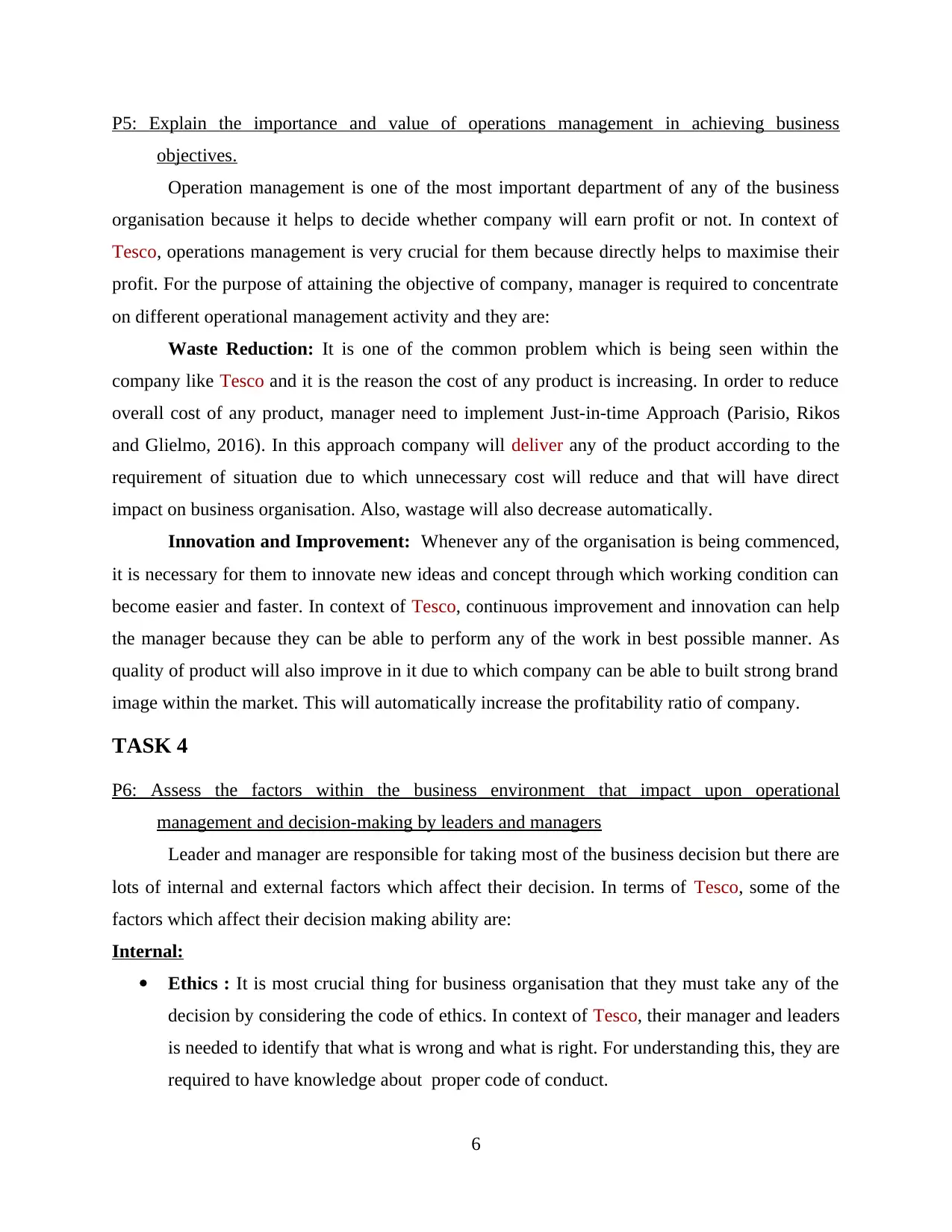
P5: Explain the importance and value of operations management in achieving business
objectives.
Operation management is one of the most important department of any of the business
organisation because it helps to decide whether company will earn profit or not. In context of
Tesco, operations management is very crucial for them because directly helps to maximise their
profit. For the purpose of attaining the objective of company, manager is required to concentrate
on different operational management activity and they are:
Waste Reduction: It is one of the common problem which is being seen within the
company like Tesco and it is the reason the cost of any product is increasing. In order to reduce
overall cost of any product, manager need to implement Just-in-time Approach (Parisio, Rikos
and Glielmo, 2016). In this approach company will deliver any of the product according to the
requirement of situation due to which unnecessary cost will reduce and that will have direct
impact on business organisation. Also, wastage will also decrease automatically.
Innovation and Improvement: Whenever any of the organisation is being commenced,
it is necessary for them to innovate new ideas and concept through which working condition can
become easier and faster. In context of Tesco, continuous improvement and innovation can help
the manager because they can be able to perform any of the work in best possible manner. As
quality of product will also improve in it due to which company can be able to built strong brand
image within the market. This will automatically increase the profitability ratio of company.
TASK 4
P6: Assess the factors within the business environment that impact upon operational
management and decision-making by leaders and managers
Leader and manager are responsible for taking most of the business decision but there are
lots of internal and external factors which affect their decision. In terms of Tesco, some of the
factors which affect their decision making ability are:
Internal:
Ethics : It is most crucial thing for business organisation that they must take any of the
decision by considering the code of ethics. In context of Tesco, their manager and leaders
is needed to identify that what is wrong and what is right. For understanding this, they are
required to have knowledge about proper code of conduct.
6
objectives.
Operation management is one of the most important department of any of the business
organisation because it helps to decide whether company will earn profit or not. In context of
Tesco, operations management is very crucial for them because directly helps to maximise their
profit. For the purpose of attaining the objective of company, manager is required to concentrate
on different operational management activity and they are:
Waste Reduction: It is one of the common problem which is being seen within the
company like Tesco and it is the reason the cost of any product is increasing. In order to reduce
overall cost of any product, manager need to implement Just-in-time Approach (Parisio, Rikos
and Glielmo, 2016). In this approach company will deliver any of the product according to the
requirement of situation due to which unnecessary cost will reduce and that will have direct
impact on business organisation. Also, wastage will also decrease automatically.
Innovation and Improvement: Whenever any of the organisation is being commenced,
it is necessary for them to innovate new ideas and concept through which working condition can
become easier and faster. In context of Tesco, continuous improvement and innovation can help
the manager because they can be able to perform any of the work in best possible manner. As
quality of product will also improve in it due to which company can be able to built strong brand
image within the market. This will automatically increase the profitability ratio of company.
TASK 4
P6: Assess the factors within the business environment that impact upon operational
management and decision-making by leaders and managers
Leader and manager are responsible for taking most of the business decision but there are
lots of internal and external factors which affect their decision. In terms of Tesco, some of the
factors which affect their decision making ability are:
Internal:
Ethics : It is most crucial thing for business organisation that they must take any of the
decision by considering the code of ethics. In context of Tesco, their manager and leaders
is needed to identify that what is wrong and what is right. For understanding this, they are
required to have knowledge about proper code of conduct.
6
⊘ This is a preview!⊘
Do you want full access?
Subscribe today to unlock all pages.

Trusted by 1+ million students worldwide
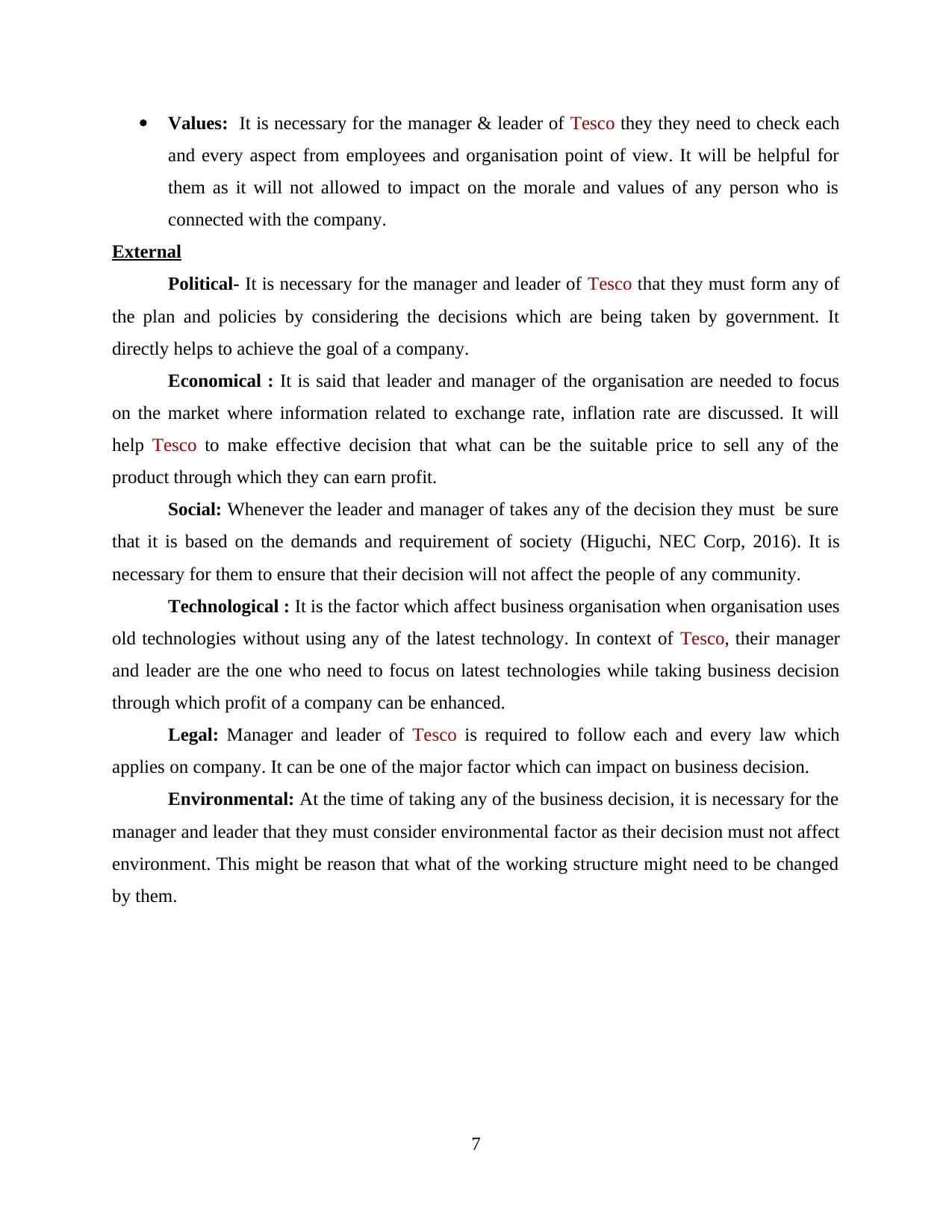
Values: It is necessary for the manager & leader of Tesco they they need to check each
and every aspect from employees and organisation point of view. It will be helpful for
them as it will not allowed to impact on the morale and values of any person who is
connected with the company.
External
Political- It is necessary for the manager and leader of Tesco that they must form any of
the plan and policies by considering the decisions which are being taken by government. It
directly helps to achieve the goal of a company.
Economical : It is said that leader and manager of the organisation are needed to focus
on the market where information related to exchange rate, inflation rate are discussed. It will
help Tesco to make effective decision that what can be the suitable price to sell any of the
product through which they can earn profit.
Social: Whenever the leader and manager of takes any of the decision they must be sure
that it is based on the demands and requirement of society (Higuchi, NEC Corp, 2016). It is
necessary for them to ensure that their decision will not affect the people of any community.
Technological : It is the factor which affect business organisation when organisation uses
old technologies without using any of the latest technology. In context of Tesco, their manager
and leader are the one who need to focus on latest technologies while taking business decision
through which profit of a company can be enhanced.
Legal: Manager and leader of Tesco is required to follow each and every law which
applies on company. It can be one of the major factor which can impact on business decision.
Environmental: At the time of taking any of the business decision, it is necessary for the
manager and leader that they must consider environmental factor as their decision must not affect
environment. This might be reason that what of the working structure might need to be changed
by them.
7
and every aspect from employees and organisation point of view. It will be helpful for
them as it will not allowed to impact on the morale and values of any person who is
connected with the company.
External
Political- It is necessary for the manager and leader of Tesco that they must form any of
the plan and policies by considering the decisions which are being taken by government. It
directly helps to achieve the goal of a company.
Economical : It is said that leader and manager of the organisation are needed to focus
on the market where information related to exchange rate, inflation rate are discussed. It will
help Tesco to make effective decision that what can be the suitable price to sell any of the
product through which they can earn profit.
Social: Whenever the leader and manager of takes any of the decision they must be sure
that it is based on the demands and requirement of society (Higuchi, NEC Corp, 2016). It is
necessary for them to ensure that their decision will not affect the people of any community.
Technological : It is the factor which affect business organisation when organisation uses
old technologies without using any of the latest technology. In context of Tesco, their manager
and leader are the one who need to focus on latest technologies while taking business decision
through which profit of a company can be enhanced.
Legal: Manager and leader of Tesco is required to follow each and every law which
applies on company. It can be one of the major factor which can impact on business decision.
Environmental: At the time of taking any of the business decision, it is necessary for the
manager and leader that they must consider environmental factor as their decision must not affect
environment. This might be reason that what of the working structure might need to be changed
by them.
7
Paraphrase This Document
Need a fresh take? Get an instant paraphrase of this document with our AI Paraphraser
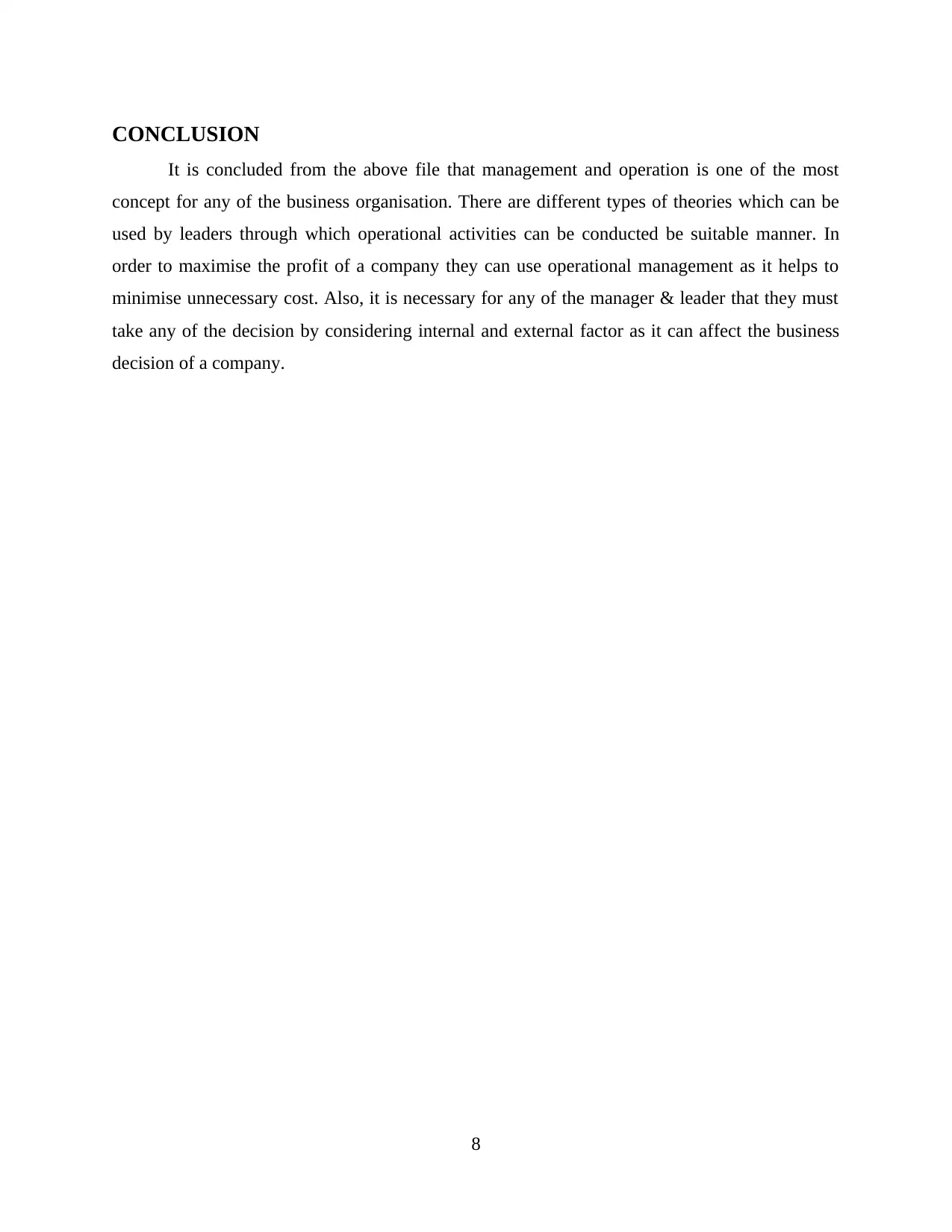
CONCLUSION
It is concluded from the above file that management and operation is one of the most
concept for any of the business organisation. There are different types of theories which can be
used by leaders through which operational activities can be conducted be suitable manner. In
order to maximise the profit of a company they can use operational management as it helps to
minimise unnecessary cost. Also, it is necessary for any of the manager & leader that they must
take any of the decision by considering internal and external factor as it can affect the business
decision of a company.
8
It is concluded from the above file that management and operation is one of the most
concept for any of the business organisation. There are different types of theories which can be
used by leaders through which operational activities can be conducted be suitable manner. In
order to maximise the profit of a company they can use operational management as it helps to
minimise unnecessary cost. Also, it is necessary for any of the manager & leader that they must
take any of the decision by considering internal and external factor as it can affect the business
decision of a company.
8
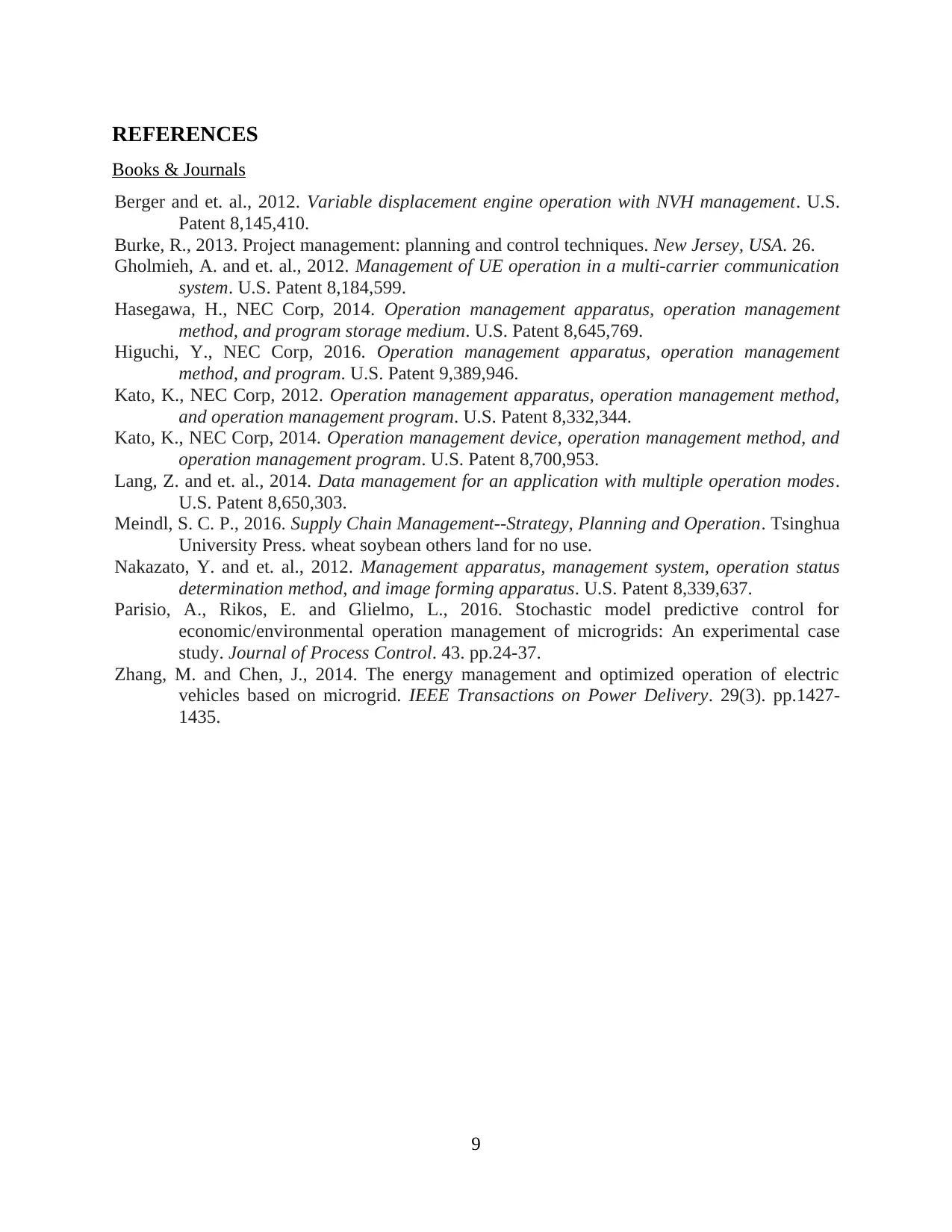
REFERENCES
Books & Journals
Berger and et. al., 2012. Variable displacement engine operation with NVH management. U.S.
Patent 8,145,410.
Burke, R., 2013. Project management: planning and control techniques. New Jersey, USA. 26.
Gholmieh, A. and et. al., 2012. Management of UE operation in a multi-carrier communication
system. U.S. Patent 8,184,599.
Hasegawa, H., NEC Corp, 2014. Operation management apparatus, operation management
method, and program storage medium. U.S. Patent 8,645,769.
Higuchi, Y., NEC Corp, 2016. Operation management apparatus, operation management
method, and program. U.S. Patent 9,389,946.
Kato, K., NEC Corp, 2012. Operation management apparatus, operation management method,
and operation management program. U.S. Patent 8,332,344.
Kato, K., NEC Corp, 2014. Operation management device, operation management method, and
operation management program. U.S. Patent 8,700,953.
Lang, Z. and et. al., 2014. Data management for an application with multiple operation modes.
U.S. Patent 8,650,303.
Meindl, S. C. P., 2016. Supply Chain Management--Strategy, Planning and Operation. Tsinghua
University Press. wheat soybean others land for no use.
Nakazato, Y. and et. al., 2012. Management apparatus, management system, operation status
determination method, and image forming apparatus. U.S. Patent 8,339,637.
Parisio, A., Rikos, E. and Glielmo, L., 2016. Stochastic model predictive control for
economic/environmental operation management of microgrids: An experimental case
study. Journal of Process Control. 43. pp.24-37.
Zhang, M. and Chen, J., 2014. The energy management and optimized operation of electric
vehicles based on microgrid. IEEE Transactions on Power Delivery. 29(3). pp.1427-
1435.
9
Books & Journals
Berger and et. al., 2012. Variable displacement engine operation with NVH management. U.S.
Patent 8,145,410.
Burke, R., 2013. Project management: planning and control techniques. New Jersey, USA. 26.
Gholmieh, A. and et. al., 2012. Management of UE operation in a multi-carrier communication
system. U.S. Patent 8,184,599.
Hasegawa, H., NEC Corp, 2014. Operation management apparatus, operation management
method, and program storage medium. U.S. Patent 8,645,769.
Higuchi, Y., NEC Corp, 2016. Operation management apparatus, operation management
method, and program. U.S. Patent 9,389,946.
Kato, K., NEC Corp, 2012. Operation management apparatus, operation management method,
and operation management program. U.S. Patent 8,332,344.
Kato, K., NEC Corp, 2014. Operation management device, operation management method, and
operation management program. U.S. Patent 8,700,953.
Lang, Z. and et. al., 2014. Data management for an application with multiple operation modes.
U.S. Patent 8,650,303.
Meindl, S. C. P., 2016. Supply Chain Management--Strategy, Planning and Operation. Tsinghua
University Press. wheat soybean others land for no use.
Nakazato, Y. and et. al., 2012. Management apparatus, management system, operation status
determination method, and image forming apparatus. U.S. Patent 8,339,637.
Parisio, A., Rikos, E. and Glielmo, L., 2016. Stochastic model predictive control for
economic/environmental operation management of microgrids: An experimental case
study. Journal of Process Control. 43. pp.24-37.
Zhang, M. and Chen, J., 2014. The energy management and optimized operation of electric
vehicles based on microgrid. IEEE Transactions on Power Delivery. 29(3). pp.1427-
1435.
9
⊘ This is a preview!⊘
Do you want full access?
Subscribe today to unlock all pages.

Trusted by 1+ million students worldwide
1 out of 12
Related Documents
Your All-in-One AI-Powered Toolkit for Academic Success.
+13062052269
info@desklib.com
Available 24*7 on WhatsApp / Email
![[object Object]](/_next/static/media/star-bottom.7253800d.svg)
Unlock your academic potential
Copyright © 2020–2025 A2Z Services. All Rights Reserved. Developed and managed by ZUCOL.





